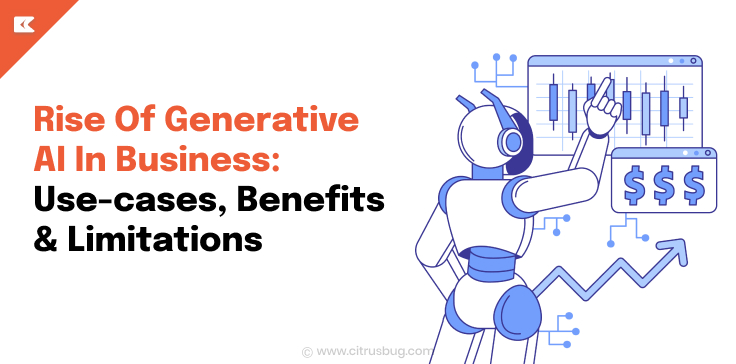Rise Of Generative AI In Business: Use-cases, Benefits & Limitations
- February 7, 2025
-
3608 Views
- by Ishan Vyas
Generative AI is no less than a technological wonder. Like the invention of mobile phones and the Internet, it’s also a significant innovation worldwide. Understanding Generative AI is crucial as it has found its application across different sectors, and its penetration in other fields is increasing daily. Projecting the involvement of AI in business, Forbes says that generative AI will have a 36% average annual growth rate by 2030.
This means that today is just the beginning; the integration of AI into business will be at its peak in the coming days. However, we are currently concerned about where AI is being applied and what benefits it offers. Does it have any limitations? If yes, how do they affect the business? This article will answer all these questions.
Use Cases Of Generative AI By Industry
Let’s discuss the possible use cases of generative AI in different industries individually.
FinTech
Generative AI has changed the way risk modeling is done in financial services. It has eliminated the need to use traditional methods to assess risks. Wondering how? AI models allow finance institutes and banks to create realistic simulations of market scenarios, enabling them to predict market trends based on simulated data.
As a result, they can make better decisions about where to invest their resources. AI-powered systems can also be trained on vast amounts of existing data to generate complex financial reports. Moreover, they can be utilized to create personalized investment strategies based on user prompts.
Content Creation
Generative AI is revolutionizing content creation by automating text generation, improving readability, and refining language accuracy. Businesses can leverage AI-powered tools to create high-quality content effortlessly.
Similarly, an AI-driven paraphrasing tool online enhances sentence structure and coherence, improving clarity, readability, and engagement by rephrasing text while maintaining its original meaning. Whether you’re refining existing content, avoiding redundancy, or adapting writing for different audiences, a paraphrasing tool ensures a polished and professional outcome.
For instance, an advanced grammar checker online helps identify and correct grammatical errors, ensuring clarity and professionalism in writing. Additionally, text summarization tools condense lengthy documents into concise summaries, saving time and improving comprehension. Generative AI streamlines the process of crafting new content or enhancing existing text, making content creation faster and more efficient.
Logistics
If you belong to logistics, you might know that transportation is a big part of this industry. Companies try to deliver their goods all across the country cost-effectively. Generative AI systems help businesses cut the costs of transporting their products from one place to another. But the question is how?
The AI-driven models analyze all the delivery routes and locations where the orders will be delivered. Then, the intelligent algorithms compare all vehicles’ routes and expected stops to determine the best paths. After examining the available options, they prefer the routes that offer lower transportation costs.
Healthcare
Diagnosis of complicated diseases has never been so easy as today; the credit goes to generative AI. AI models with robust deep neural networks and vision-based technology analyze existing patients’ records efficiently. They can scan medical images, such as X-rays, MRIs, and CT scans, and predict the disease accurately based on training data.
AI-based medical assistants can be particularly helpful in diagnosing cancer, tumors, fractures, and severe structural issues in the human body. They can also suggest personalized medicine, based on the patient’s previous history. The best part is that AI-based medical models can work around the clock without getting tired.
E-Learning
One major field where generative AI has emerged as a significant innovation is e-learning. Before integrating AI systems, educational experiences had never been so personalized. AI models analyze students’ learning behaviors and provide customized suggestions to help them grow.
AI models can be trained to create quizzes, tests, and screening material based on the intellectual level of the learners. This ensures that every student gets the facility to enhance their knowledge, expertise, or language skills in a style or manner they want. driving the latest edtech trends forward.
E-commerce
Customer support and experience are the two key factors defining the success of any e-commerce business. Fortunately, generative AI contributes to both of these areas. AI algorithms help potential buyers have a smooth buying journey by recommending the most relevant products that match their interests and previous browsing behaviors.
On the other hand, AI-powered chatbots efficiently handle customer queries. They can respond to many customers simultaneously, and the surprising fact is that each response is personalized to satisfy consumers. AI is revolutionizing e-commerce by reducing manual efforts and increasing system efficiency.
Real Estate
Generative AI contributes to real estate in various ways. It simplifies decision-making when finding the best investment options. Based on the training data, it analyzes property descriptions and makes an accurate choice that seems most profitable. In addition, AI image generation tools allow realtors to create exceptional 3D models of residential and commercial properties. Approximately 85% of real estate firms have adopted AI to streamline operations and enhance decision-making processes.
AI models that create visuals can also be used for interior and exterior design inspirations. This reduces the need to visit different locations to have an idea for the next project. Moreover, it eliminates the requirement to hire a dedicated designer to generate creative designs for innovative projects that need stunning yet unique architecture.
Marketing
Generative AI is another prominent field benefiting from marketing. It automates the creation of ad copies and creatives for email campaigns and social media like reels, posts, etc.. What makes AI suitable for marketing is its ability to personalize each copy and visual according to the potential customer’s interests and behaviors, increasing the chances of conversions.
In addition to creating marketing material, AI-powered models also help make better decisions regarding audience targeting. You can ask an AI chatbot to analyze vast data of existing customers and previous sales records and suggest the best demographics and interests to target in social media ads. The correct targeting with the help of AI can make a significant difference in your ROI. Using these insights can also help refine a broader social media marketing strategy for consistent and effective campaigns.
Prominent Advantages Of Generative AI
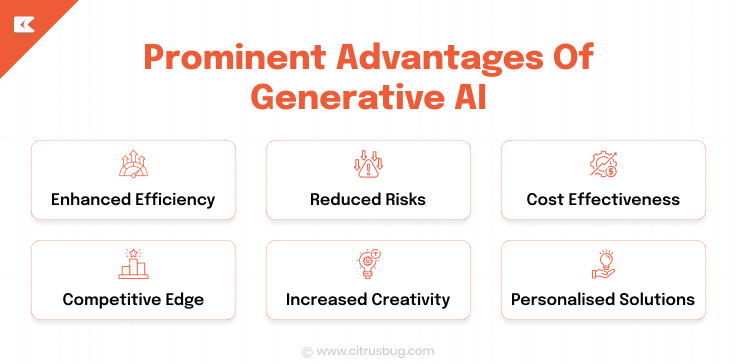
Enhanced Efficiency
Businesses always seek efficient solutions to save their time and increase productivity. Generative AI appears to be the most productive way to handle different processes, significantly reducing time consumption. For instance, if you produce a marketing copy manually, crafting a persuasive text may take hours. However, if you utilize the power of AI tools, generating personalized copies is just a few seconds away.
Reduced Risks
Every company wants to face the fewest risks in business. In this regard, AI offers many contributions. Whether making an investment or accurately diagnosing a disease, AI models provide risk-free suggestions to avoid unwanted issues. They make instant predictive data analyses and provide the users with the most suitable advice based on a scenario. This approach helps businesses avoid costly failures that might endanger their company.
Cost-Effectiveness
Another way generative AI benefits businesses is by reducing their operational costs. For instance, hiring a dedicated team is unnecessary in the presence of free AI content creation tools. Similarly, the integration of chatbots in customer support has just one cost. This reduces the requirement to do hiring for the support team. These are just two cases; AI helps to reduce expenses in many situations, especially in marketing, content creation, e-commerce, and logistics.
Competitive Edge
Staying ahead of the competition is essential to dominate the market. Companies can leave their competitors behind by integrating generative AI models into their systems. Or they can start relying on online AI tools for their repetitive tasks to stay more productive than others. This provides them an edge over other brands, which helps them grow at a faster pace than competitive businesses. Since many companies are still unaware of the power of AI, you can become an industry leader by incorporating AI into your systems.
Increased Creativity
Creativity is the key to innovations in businesses. New ideas bring new opportunities and solve existing problems efficiently. However, coming up with unique ideas is not as easy as it seems. Even the most senior professional can experience creative block sometimes. This is where AI-powered models come in handy. You can use such systems to get customized answers to every query that comes to your mind. You can get creative ideas by having comprehensive conversations with such models.
Personalized Solutions
Personalization is the most beneficial trait of generative AI. As the use cases mentioned, AI provides personalized outputs that perfectly fit your situation. Whether you want a specific type of content or wish to optimize product suggestions on your e-commerce store, AI can help you personalize different things. This facility allows you to generate the outputs of your choice to make the most of AI capabilities.
Limitations Of Generative AI In Business
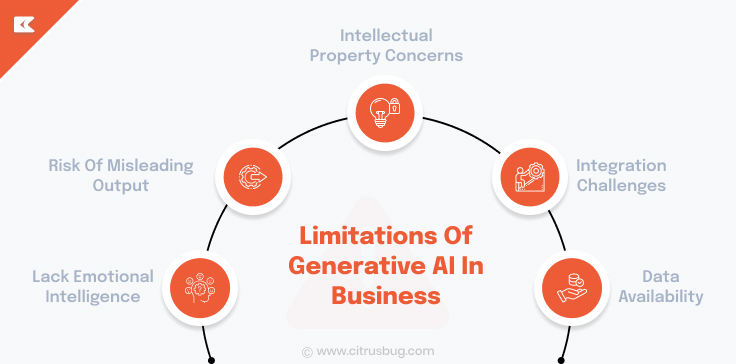
Lack Emotional Intelligence
Remember, AI models can’t think like humans. Similarly, they don’t have emotions and struggle with emotional intelligence. For instance, if you ask an AI writing assistant to write a persuasive ad copy, the text generated by the tool may be less appealing regarding emotions. In the case of customer service, the responses of AI chatbots may fail to satisfy the customers emotionally. This limitation requires humans to work along with AI to fill this gap.
Risk Of Misleading Output
You might have heard that AI models heavily rely on the data they are trained on. If the data has biases, you may also get biased outputs. Similarly, the generated text can have factual inaccuracies if the data has outdated information. This poses risks for businesses that get help from AI in decision-making. So, inaccurate or irrelevant responses can harm companies that blindly rely on AI.
Intellectual Property Concerns
Using AI in different fields, especially marketing and content creation, raises questions about intellectual property rights. For instance, if you create an article using the AI tool, the question is who owns it: you, the AI tool, or the company that made it. Apart from that, if the output of the AI models unintentionally matches existing information, who will violate copyright laws, you or the tool? All such questions are still under discussion by experts and may be answered shortly.
Integration Challenges
When capitalizing on generative AI, you have two options: either use online tools or create dedicated models for your systems. The first option is easy to access, but the second poses integration challenges, especially when your systems are outdated. In such situations, you must first update your systems to support AI models’ APIs. This requires you to have a skilled team that can handle the technical part of the integration.
Data Availability
As discussed, generative AI models depend on training data to generate outputs. Here, data means many existing facts, figures, statistics, examples, scenarios, and many more things. Collecting vast amounts of data for their training could be a big challenge if you try to build your own AI models. Since you need quality outputs, the data must also be credible, authentic, and free from any type of error. This dependency creates problems in gathering reliable data to train the AI models in an intended way.
To Sum Up
Generative AI is more than just a trend—it’s a game-changer that’s transforming industries, from finance and healthcare to e-learning and e-commerce. Its ability to automate tasks, personalize experiences, and enhance decision-making makes it an invaluable tool for businesses looking to stay ahead. But like any powerful technology, it comes with challenges—misleading outputs, ethical concerns, and integration hurdles.
The key isn’t to replace humans but to work alongside AI, using its strengths while navigating its limitations. As generative AI development continues to evolve, businesses that embrace it thoughtfully will unlock new opportunities and redefine the way they operate in the digital age.


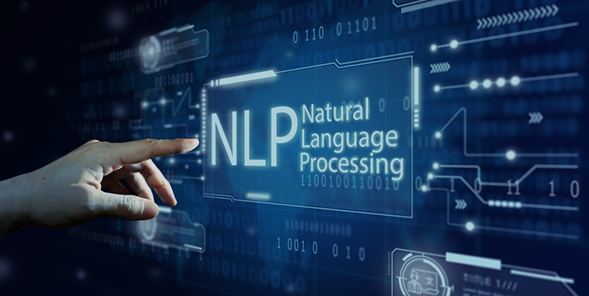
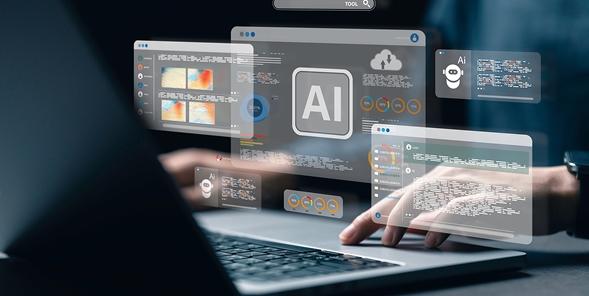

 SaaS Development
SaaS Development Web Application Development
Web Application Development Mobile Application Development
Mobile Application Development Custom Software Development
Custom Software Development Cloud Development
Cloud Development DevOps Development
DevOps Development MVP Development
MVP Development Digital Product Development
Digital Product Development Hire Chatbot Developers
Hire Chatbot Developers Hire Python Developers
Hire Python Developers Hire Django Developers
Hire Django Developers Hire ReactJS Developers
Hire ReactJS Developers Hire AngularJS Developers
Hire AngularJS Developers Hire VueJS Developers
Hire VueJS Developers Hire Full Stack Developers
Hire Full Stack Developers Hire Back End Developers
Hire Back End Developers Hire Front End Developers
Hire Front End Developers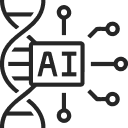 AI Healthcare Software Development & Consulting
AI Healthcare Software Development & Consulting Healthcare App Development
Healthcare App Development EHR Software Development
EHR Software Development Healthcare AI Chatbot Development
Healthcare AI Chatbot Development Telemedicine App Development Company
Telemedicine App Development Company Medical Billing Software Development
Medical Billing Software Development Fitness App Development
Fitness App Development RPM Software Development
RPM Software Development Medicine Delivery App Development
Medicine Delivery App Development Medical Device Software Development
Medical Device Software Development Patient Engagement Software Solutions
Patient Engagement Software Solutions Mental Health App Development
Mental Health App Development Healthcare IT Consulting
Healthcare IT Consulting Healthcare CRM Software Development
Healthcare CRM Software Development Healthcare IT Managed Services
Healthcare IT Managed Services Healthcare Software Testing services
Healthcare Software Testing services Medical Practice Management Software
Medical Practice Management Software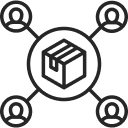 Outsourcing Healthcare IT Services
Outsourcing Healthcare IT Services IoT Solutions for Healthcare
IoT Solutions for Healthcare Medical Image Analysis Software Development Services
Medical Image Analysis Software Development Services Lending Software Development Services
Lending Software Development Services Payment Gateway Software Development
Payment Gateway Software Development Accounting Software Development
Accounting Software Development AI-Driven Banking App Development
AI-Driven Banking App Development Insurance Software Development
Insurance Software Development Finance Software Development
Finance Software Development Loan Management Software Development
Loan Management Software Development Decentralized Finance Development Services
Decentralized Finance Development Services eWallet App Development
eWallet App Development Payment App Development
Payment App Development Money Transfer App Development
Money Transfer App Development Mortgage Software Development
Mortgage Software Development Insurance Fraud Detection Software Development
Insurance Fraud Detection Software Development Wealth Management Software Development
Wealth Management Software Development Cryptocurrency Exchange Platform Development
Cryptocurrency Exchange Platform Development Neobank App Development
Neobank App Development Stock Trading App Development
Stock Trading App Development AML software Development
AML software Development Web3 Wallet Development
Web3 Wallet Development Robo-Advisor App Development
Robo-Advisor App Development Supply Chain Management Software Development
Supply Chain Management Software Development Fleet Management Software Development
Fleet Management Software Development Warehouse Management Software Development
Warehouse Management Software Development LMS Development
LMS Development Education App Development
Education App Development Inventory Management Software Development
Inventory Management Software Development Property Management Software Development
Property Management Software Development Real Estate CRM Software Development
Real Estate CRM Software Development Real Estate Document Management Software
Real Estate Document Management Software Construction App Development
Construction App Development Construction ERP Software Development
Construction ERP Software Development





